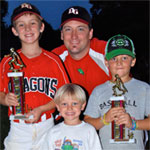How to Hit Breaking Balls and Flame-Throwers
As we heat up into midseason form (and if two replies I received are any indication, we are in midseason form…you know who you are), our mechanics are inevitably changing. In the beginning of the season when the weather is colder, it takes us longer to get loose and to stay loose. We tend to be a little stiffer and not as flexible. Baseball isn’t a very active sport; there is a lot of standing around and short bursts. When the warmer weather comes, it is much easier to get loose and stay warm. With that in mind, pitchers begin to throw harder and subsequently start throwing more off-speed pitches because now their arms are feeling stronger. It is at this point that some hitters are now starting to struggle to catch up.
Baseball is game of adjustments. If a hitter tends to pull, we play him that way. If he tends to swing late, we play him that way. As a hitter, we have to make adjustments as well. So what do we do to catch up? Get the front foot down earlier.
When we have discussed proper hitting fundamentals previously, we separated the stride from the swing. They are two separate and distinct movements. What sometimes happens is you start combining the stride and the swing into one movement. To illustrate this, think of your hands starting to come forward before your front foot hits. This is striding and swinging at the same time. It produces a couple problems. The first is not being able to hit a breaking ball with any authority. The only way to consistently hit an off-speed pitch hard is to keep your hands back. When your hands start forward before your front foot hits, you start swinging at off-speed pitches way out in front of home plate. The second is regarding a pitcher that is throwing harder. The ball is on you faster and your front foot has not had a chance to land and you are forced to swing at the pitch before your hands and body are ready. When this happens you swing way late.
If you remember one golden rule, remember this: Your front foot must land before you swing and you have to keep your hands back (I guess that’s two rules). If you can consistently master this skill, you will have a consistent and productive career. In a perfect world, your front foot lands, you are balanced, your hands are back.
So let’s fix the problem. When faced with a pitcher throwing harder than you are used to, make sure your front foot lands a little sooner. Make the adjustment. If you feel you are behind every fastball, speed up your approach. Start your stride a little earlier to ensure the ball is in the hitting zone when that front foot lands and not past it. Remember, hitting is timing. Don’t make the mistake of trying to swing harder to catch up to the pitch. Wrong approach. The thought of swinging harder tells me more tension in the wrist and forearms, creating a slower bat. Think quicker…fast hands. Keep the tension out of your hands and arms.
Having problems with breaking pitches, make sure when that front foot lands, your hands are back.
Two great if not boring drills come to mind. First, practice striding without a pitcher. This can be done by yourself. Assume your regular stance in a game situation, facing the pitcher. Take your stride and make sure as your front foot lands your hands have loaded and are in a strong hitting position back by your back shoulder (Note: your hands need to be back when the foot hits. It is at this moment when you decide to swing or not.). Pause. Relax. Repeat 50 times everyday until it becomes a habit.
Another drill is during batting practice. Practice taking breaking pitches and fastballs, keeping your hands up and back. This can even be done on the side. Set up a hitting station and get hitters in the habit of taking pitches properly.
One of the things I try and get my hitters to do is create good habits. Whenever we take batting practice, whether soft toss or live, they are instructed to take pitches properly. Very important. Create good habits! Practice is the time to do this.
Hope everyone has a great weekend! Contact me with your questions and concerns.
Coach Joe

